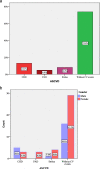Evaluation of cardiovascular risk factors in patients with familial hypercholesterolemia from the North-Eastern area of Romania
- PMID: 33430859
- PMCID: PMC7798287
- DOI: 10.1186/s12944-020-01428-y
Evaluation of cardiovascular risk factors in patients with familial hypercholesterolemia from the North-Eastern area of Romania
Abstract
Background: Familial hypercholesterolemia(FH) is one of the most frequent and important monogenic cholesterol pathologies. Traditional and non-traditional cardiovascular risk factors increase the prevalence of atherosclerotic cardiovascular disease(ASCVD) in this population. The aims of the study were: (a) to identify FH patients in the North-Eastern part of Romania and to analyze demographic, clinical and paraclinical data (b) to evaluate the risk of new cardiovascular events at follow-up in FH patients stratified by lipid-lowering agents.
Methods: This first prospective study in the North-Eastern part of Romania was carried out between October 2017 and October 2019; out of 980 patients with dyslipidemia evaluated with the Dutch Lipid Network(DLCN) and Simon Broome(SM) scores, 61 patients with DLCN score above 3 and possible/probable FH(SM score) were included.
Results: Nine hundred-eighty patients were examined and 61 (6.2%) were received the clinical diagnosis of FH. The mean age was 48.5±12.5 years, with more female patients than male patients (63.9% versus 36%). Hypertension was the main cardiovascular risk factor for both genders, followed by physical inactivity and obesity for the female group and active smoking for the male group. The measured DLCN score recorded: "possible" FH identified in 39.4%, "probable" FH in 45.9% and "definite" FH in 14.7%. The effective lipid-lowering drugs used were statin alone and statin in association with fenofibrate, which improved both the lipid profile values and the subclinical atherosclerosis markers (ankle-brachial index, carotid intima-media thickness and high-sensitivity C-reactive protein). New ASCVDs that emerged during the study were most commonly represented by coronary heart disease and stroke. At the same time, the new cardiovascular events were delayed in patients receiving the lipid-lowering drugs, without significant differences between them.
Conclusions: In patients with suspected FH, the lipid-lowering agents during the follow-up period delayed the new cardiovascular events, yet failed to reach the goals proposed by the guidelines.
Keywords: Ankle-brachial index; Atherosclerotic cardiovascular disease; Cardiovascular risk factors; Carotid intima-media thickness; Familial hypercholesterolemia; Low density lipoprotein cholesterol.
Conflict of interest statement
The author(s) declare(s) that there is no conflict of interest regarding the publication of this paper.
Figures





Similar articles
-
Preliminary data of familial hypercholesterolemia (FH) patients in Romania.Atherosclerosis. 2018 Oct;277:304-307. doi: 10.1016/j.atherosclerosis.2018.08.015. Atherosclerosis. 2018. PMID: 30270063
-
Prevalence and pharmacologic management of familial hypercholesterolemia in an unselected contemporary cohort of patients with stable coronary artery disease.Clin Cardiol. 2018 Aug;41(8):1075-1083. doi: 10.1002/clc.23031. Epub 2018 Aug 20. Clin Cardiol. 2018. PMID: 30039543 Free PMC article.
-
Detecting familial hypercholesterolemia by serum lipid profile screening in a hospital setting: Clinical, genetic and atherosclerotic burden profile.Nutr Metab Cardiovasc Dis. 2018 Jan;28(1):35-43. doi: 10.1016/j.numecd.2017.07.003. Epub 2017 Jul 18. Nutr Metab Cardiovasc Dis. 2018. PMID: 28958694
-
Genetic testing for familial hypercholesterolemia: Impact on diagnosis, treatment and cardiovascular risk.Eur J Prev Cardiol. 2019 Aug;26(12):1262-1270. doi: 10.1177/2047487319829746. Epub 2019 Feb 12. Eur J Prev Cardiol. 2019. PMID: 30755017
-
Reducing cardiovascular risk in patients with familial hypercholesterolemia: Risk prediction and lipid management.Prog Cardiovasc Dis. 2019 Sep-Oct;62(5):414-422. doi: 10.1016/j.pcad.2019.10.003. Epub 2019 Oct 25. Prog Cardiovasc Dis. 2019. PMID: 31669498 Review.
Cited by
-
Genetic variants and carotid atherosclerosis progression in familial hypercholesterolemia: a comprehensive review.Front Cardiovasc Med. 2025 May 29;12:1526093. doi: 10.3389/fcvm.2025.1526093. eCollection 2025. Front Cardiovasc Med. 2025. PMID: 40510188 Free PMC article.
-
Molecular Genetic Approach and Evaluation of Cardiovascular Events in Patients with Clinical Familial Hypercholesterolemia Phenotype from Romania.J Clin Med. 2021 Mar 31;10(7):1399. doi: 10.3390/jcm10071399. J Clin Med. 2021. PMID: 33807407 Free PMC article.
-
Lipoprotein metabolism in familial hypercholesterolemia.J Lipid Res. 2021;62:100062. doi: 10.1016/j.jlr.2021.100062. Epub 2021 Mar 3. J Lipid Res. 2021. PMID: 33675717 Free PMC article. Review.
-
Assessment of Associations Between Serum Lipoprotein (a) Levels and Atherosclerotic Vascular Diseases in Hungarian Patients With Familial Hypercholesterolemia Using Data Mining and Machine Learning.Front Genet. 2022 Feb 9;13:849197. doi: 10.3389/fgene.2022.849197. eCollection 2022. Front Genet. 2022. PMID: 35222552 Free PMC article.
-
The Demographic and Lifestyle Characteristics of Patients with Familial Hypercholesterolemia Referred to a Dyslipidemia Clinic: A Cross-Sectional Single-Center Study.J Tehran Heart Cent. 2024 Jul;19(3):192-197. J Tehran Heart Cent. 2024. PMID: 40271172 Free PMC article.
References
-
- Gragnano F, Calabro P. Role of dual lipid-lowering therapy in coronary atherosclerosis regression: evidence from recent studies. Atherosclerosis. 2018;269:219–228. - PubMed
-
- Watts GF, Gidding SS, Mata P, Pang J, Sullivan DR, Yamashita S, et al. Familial hypercholesterolaemia: evolving knowledge for designing adaptive models of care. Nat Rev Cardiol. 2020;17(6):360–77. - PubMed
-
- Gidding SS, Champagne MA, de Ferranti SD, Defesche J, Ito MK, Knowles JW, et al. The agenda for familial hypercholesterolemia: a scientific statement from the American Heart Association. Circulation. 2015;132(22):2167–2192. - PubMed
MeSH terms
Substances
Grants and funding
LinkOut - more resources
Full Text Sources
Other Literature Sources
Research Materials
Miscellaneous

